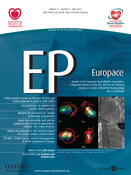Europace:存在非手术相关低电压区的右心房房速射频消融治疗效果良好
2013-05-03 Europace 丁香园
房性心动过速是临床上较常见的室上性心律失常,近年来射频消融技术成功地应用于房性心动过速的治疗。峡部依赖性房速是临床上最常见的房速类型,又被称为典型房速,射频消融峡部可成功终止房速的发作,具有很高的安全性及有效性。不典型房速主要与外科手术相关,主要表现为右房游离壁折返,右房中外侧游离壁线状消融可成功终止心动过速。还有一种不典型右心房心动过速患者既往无外科手术史,右心房标测可见心房壁存在大面积的低电压
房性心动过速是临床上较常见的室上性心律失常,近年来射频消融技术成功地应用于房性心动过速的治疗。峡部依赖性房速是临床上最常见的房速类型,又被称为典型房速,射频消融峡部可成功终止房速的发作,具有很高的安全性及有效性。不典型房速主要与外科手术相关,主要表现为右房游离壁折返,右房中外侧游离壁线状消融可成功终止心动过速。还有一种不典型右心房心动过速患者既往无外科手术史,右心房标测可见心房壁存在大面积的低电压区或无信号区,无信号区定义为心房电压小于0.05mv,低电压区表现为心房电压小于0.5mv。
为进一步明确存在非手术相关低电压区右房房速患者的电生理特征及射频消融的长期疗效,Wieczorek M等近来在Europace上发表了一篇临床研究,该研究详细描述了患者的临床及心电生理特征,并在射频消融后进行了长期的随访。
该研究分析了作者单位的327例进行射频消融的房速患者,其中7例为存在非手术相关低电压区右房房速,所有患者术中均进行了仔细的右心房标测,成功消融后进行了长期随访。结果显示:所有7例患者中共存在17种房速类型,5例患者存在右心房游离壁大面积低电压区,另外2例为房间隔疤痕。4例患者存在围绕疤痕的折返,2例患者存在穿过间隔的通道。射频消融的部位包括三尖瓣与下腔静脉的峡部,下腔静脉与疤痕区域的连接处、疤痕内的通道及左心房二尖瓣峡部。所有患者的平均随访时间的34个月, 其中4例患者无房性心律失常再发作,两例存在房间隔疤痕的患者均出现了左心房房速,并需要再次消融,1例患者出现了疤痕相关的右心房房扑。
通过该项研究可得出以下结论:标测并消融疤痕相关的右心房房速具有良好的疗效,但也有房性心动过速复发的可能性,部分患者的复发与左心房相关。
与消融相关的拓展阅读:
- JCE:既往存在胺碘酮相关甲亢的房颤患者导管消融后复发率较高
- Circulation:复杂性室性心律失常导管消融可改善患者长期预后
- CAE:房颤患者消融围手术期服用达比加群的安全性
- Hypertension:靶向交感神经消融可降低遗传盐敏感性高血压
- Europace:不间断抗凝的AF消融患者仍有无症状性脑损伤风险 更多信息请点击:有关消融更多资讯

Right atrial tachycardias related to regions of low-voltage myocardium in patients without prior cardiac surgery: catheter ablation and follow-up results.
AIMS
There are only few descriptions of patients without prior cardiac surgery in whom a large low-voltage zone (LVZ) or scar is the electrophysiological substrate for various atrial tachycardias. We describe the electrophysiological and electroanatomic characteristics of unusual macroreentrant atrial tachycardias (MRATs) in seven patients with spontaneous right atrial (RA) scarring and present long-term follow-up results.
METHODS AND RESULTS
In 7 of 326 patients with MRAT treated with radiofrequency ablation we detected regions of RA spontaneous LVZ or scarring during conventional mapping of the arrhythmia. They underwent electroanatomic mapping and catheter ablation of the spontaneous and further induced arrhythmias with a long-term follow-up. A total of 17 different atrial tachycardias were observed with typical atrial flutter in four patients. In five patients a LVZ was found in the RA free wall and two patients had a septal scar. Stable circuits were around the scar or LVZ in four patients and through a 'channel' within the scar in two. Radiofrequency ablation sites included the cavotricuspid isthmus for typical atrial flutter, between the inferior vena cava and scar, a channel in the scar or the left atrial (LA) mitral isthmus. During follow-up of 34 ± 5 months, four patients were free from atrial tachycardias. Both patients with a septal RA scar developed LA tachycardias, requiring further catheter ablation. One patient presented with a novel type of atypical scar-related RA flutter.
CONCLUSION
Mapping and ablation of scar-related RA tachycardias is an effective treatment but does not preclude the development of further tachycardias, some of them arising from the LA during long-term follow-up.
本网站所有内容来源注明为“梅斯医学”或“MedSci原创”的文字、图片和音视频资料,版权均属于梅斯医学所有。非经授权,任何媒体、网站或个人不得转载,授权转载时须注明来源为“梅斯医学”。其它来源的文章系转载文章,或“梅斯号”自媒体发布的文章,仅系出于传递更多信息之目的,本站仅负责审核内容合规,其内容不代表本站立场,本站不负责内容的准确性和版权。如果存在侵权、或不希望被转载的媒体或个人可与我们联系,我们将立即进行删除处理。
在此留言








#ACE#
79
#右心房#
58
#治疗效果#
59
#射频消融#
61
#消融#
55
#射频消融治疗#
72
#消融治疗#
52
#心房#
64